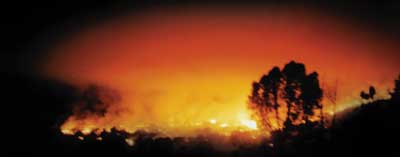|
The Magazine for
Esri Software Users |
|
|||
 Automating Spatial Processes
Automating Spatial Processes
By Valerie Spalding, Produce Marketing Specialist Models are simplified representations of natural and cultural phenomena that help us understand, describe, and predict real-world events. Spatial modeling that uses the data integration capabilities of GIS is an especially powerful methodology. A GIS-based spatial model contains processes that generate information, often in map form. Process model diagrams, also known as flow diagrams, represent the sequence of modeling and document modeling steps. ArcView Spatial Analyst 2, an extension to ArcView GIS, includes a powerful new spatial modeling interface called ModelBuilder that provides robust spatial modeling capabilities. Designed to work primarily with grid data sets, the 11 process wizards and diagramming tools in ModelBuilder let users design spatial analysis flow diagrams. Users can easily change the data sets used by the model, modify the influence of each data set on the model, perform complex analysis functions, and generate maps that illustrate the results of analysis. Data derived from one model can be used as input for another model. Once designed, a model can be run with a variety of parameters to assess data sensitivity or can be used to evaluate geographically different but structurally similar data sets. By developing standard ModelBuilder templates, users can share methodologies and data and maintain standards. The ability to easily modify both data and processes can be used for land use suitability, risk, environmental sensitivity, social impact, and other studies. In addition to exploring many different solutions, flow diagrams make it easy for someone else to understand how the analysis was performed. This is particularly valuable in public policy situations that require building consensus between different groups. ModelBuilder was used in developing a remediation plan for an ecologically important area of Southern California. Modeling Remediation Plans Careful planning may save a lake that was created quite by accident. The Salton Sea is located in the desert just north of the City of El Centro. Massive flooding in 1905 caused the Colorado River to break through an irrigation canal. Water flowed into the Salton Basin for 18 months creating California's largest inland body of water. The Salton Sea, covering 381 square miles, is now an important wildlife refuge. It hosts more than half the birds that migrate along the Pacific flyway and is home to many endangered species including the peregrine falcon, bald eagle, brown pelican, and desert pupfish. The ecological well-being of the Salton Sea has been threatened in recent years by salinity that has increased to lethal levels. With no outlet to dissipate the salt left behind after evaporation, the Salton Sea salinity now exceeds that of the Pacific Ocean by 25 percent. Fish and birds are dying in large numbers. Large algal blooms cloud the water and foul the air. The United States Bureau of Reclamation commissioned the Center for Environmental Management of the University of Redlands to devise a plan for saving the Salton Sea from ecological collapse by pumping saline water to nearby dry lake beds. Using ModelBuilder, the university team designed a suitability model that showed the least expensive routes for desalination pipelines in just four days. The model they developed incorporated data on land use, natural hazards, and slopes; factored in structures to avoid and desirable areas; and included hydrologic considerations. The least-cost paths created using ModelBuilder were compared with routes developed by engineers using paper maps. Though most paths matched, the engineers suggested several paths that required tunneling through steep slopes. These routes could be incorporated and tested in ModelBuilder very rapidly without re-creating the model. Risk Modeling In addition to suitability modeling, government agencies and emergency responders can use ModelBuilder to assess the risk of fire, flood, and other natural disasters. Testing a variety of "what if" scenarios identifies areas most likely to be affected and leads to the development of better building codes and mitigation strategies. ModelBuilder provides a tremendous vehicle for incorporating risk criteria such as the standards developed by the National Fire Protection Association (NFPA) for use in developing areas threatened by wildfire. The NFPA, a worldwide organization that has promoted fire safety and fire protection for over 100 years, developed NFPA Standard 299 entitled "Standard for Protection of Life and Property from Wildfire." The criteria covered by this standard includes ratings for topographical, fuel availability, infrastructure, meteorological, and historical factors. Using ModelBuilder, the complex interaction of these factors can be studied and the analysis process automated. The accompanying tutorial article "Modeling Fire Hazard" walks the reader through a very simplified wildfire model. This tutorial demonstrates how data is converted and incorporated in the model using functionality built into ModelBuilder.
|
